FORD EXPEDITION 1997 1.G Owners Manual
Manufacturer: FORD, Model Year: 1997, Model line: EXPEDITION, Model: FORD EXPEDITION 1997 1.GPages: 224, PDF Size: 2.2 MB
Page 191 of 224
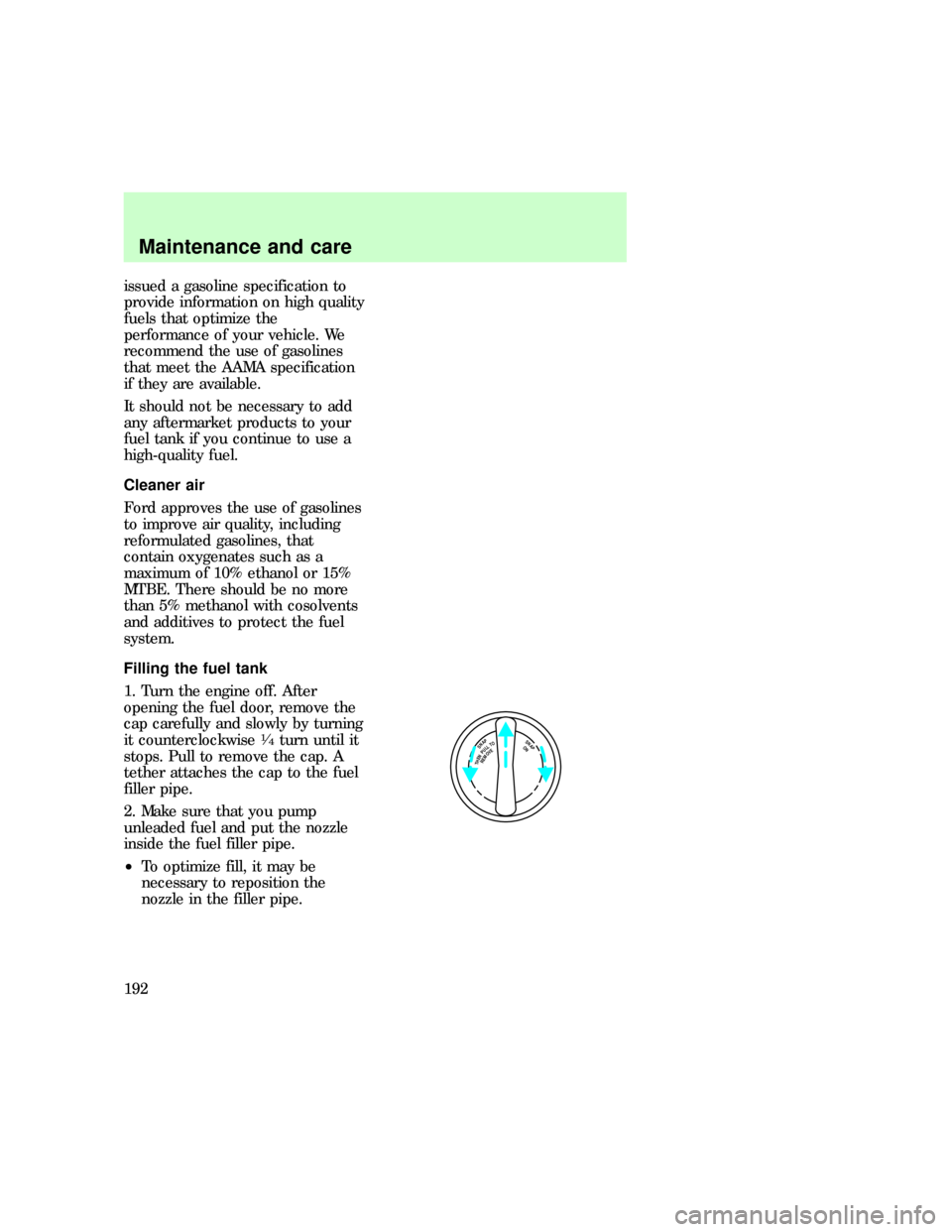
issued a gasoline specification to
provide information on high quality
fuels that optimize the
performance of your vehicle. We
recommend the use of gasolines
that meet the AAMA specification
if they are available.
It should not be necessary to add
any aftermarket products to your
fuel tank if you continue to use a
high-quality fuel.
Cleaner air
Ford approves the use of gasolines
to improve air quality, including
reformulated gasolines, that
contain oxygenates such as a
maximum of 10% ethanol or 15%
MTBE. There should be no more
than 5% methanol with cosolvents
and additives to protect the fuel
system.
Filling the fuel tank
1. Turn the engine off. After
opening the fuel door, remove the
cap carefully and slowly by turning
it counterclockwise
1¤4turn until it
stops. Pull to remove the cap. A
tether attaches the cap to the fuel
filler pipe.
2. Make sure that you pump
unleaded fuel and put the nozzle
inside the fuel filler pipe.
²To optimize fill, it may be
necessary to reposition the
nozzle in the filler pipe.SNAP
THENPULLTO
REMOVESNAPON
com_cleaner_air.01
exd_fuel_cap
Maintenance and care
192
Page 192 of 224
![FORD EXPEDITION 1997 1.G Owners Manual ²The help reduce early nozzle
shut offs and fuel spillage, park
your vehicle so that the fuel
filler door is level.
²Avoid excessively fast fuel
dispensing rates (over 38 L [10
gallons] per minute). FORD EXPEDITION 1997 1.G Owners Manual ²The help reduce early nozzle
shut offs and fuel spillage, park
your vehicle so that the fuel
filler door is level.
²Avoid excessively fast fuel
dispensing rates (over 38 L [10
gallons] per minute).](/img/11/4905/w960_4905-191.png)
²The help reduce early nozzle
shut offs and fuel spillage, park
your vehicle so that the fuel
filler door is level.
²Avoid excessively fast fuel
dispensing rates (over 38 L [10
gallons] per minute).
²If you spill any fuel on the body
of your vehicle, clean it off
immediately. The fuel may dull
or soften the paint if it is not
washed off promptly.
3. To replace the fuel cap, align
the tabs on the cap with the
notches on the filler pipe. Turn it
clockwise until it stops.
4. Push the fuel door closed.
If the check engine warning light
illuminates and remains illuminated
while the engine is started, the
fuel cap may not be properly
seated. Turn off the engine,
remove the fuel cap and replace it.
being sure to align the cap
properly.
If the fuel cap is lost, replace it
with an authorized Motorcraft or
equivalent part.
Calculating fuel economy
To accurately calculate your
vehicle's fuel economy:
1. Fill the tank completely and
record the initial odometer
reading.
2. Each time you fill the tank,
record the amount of fuel added
(in liters or gallons).
com_calculating_economy.01
Maintenance and care
193
Page 193 of 224
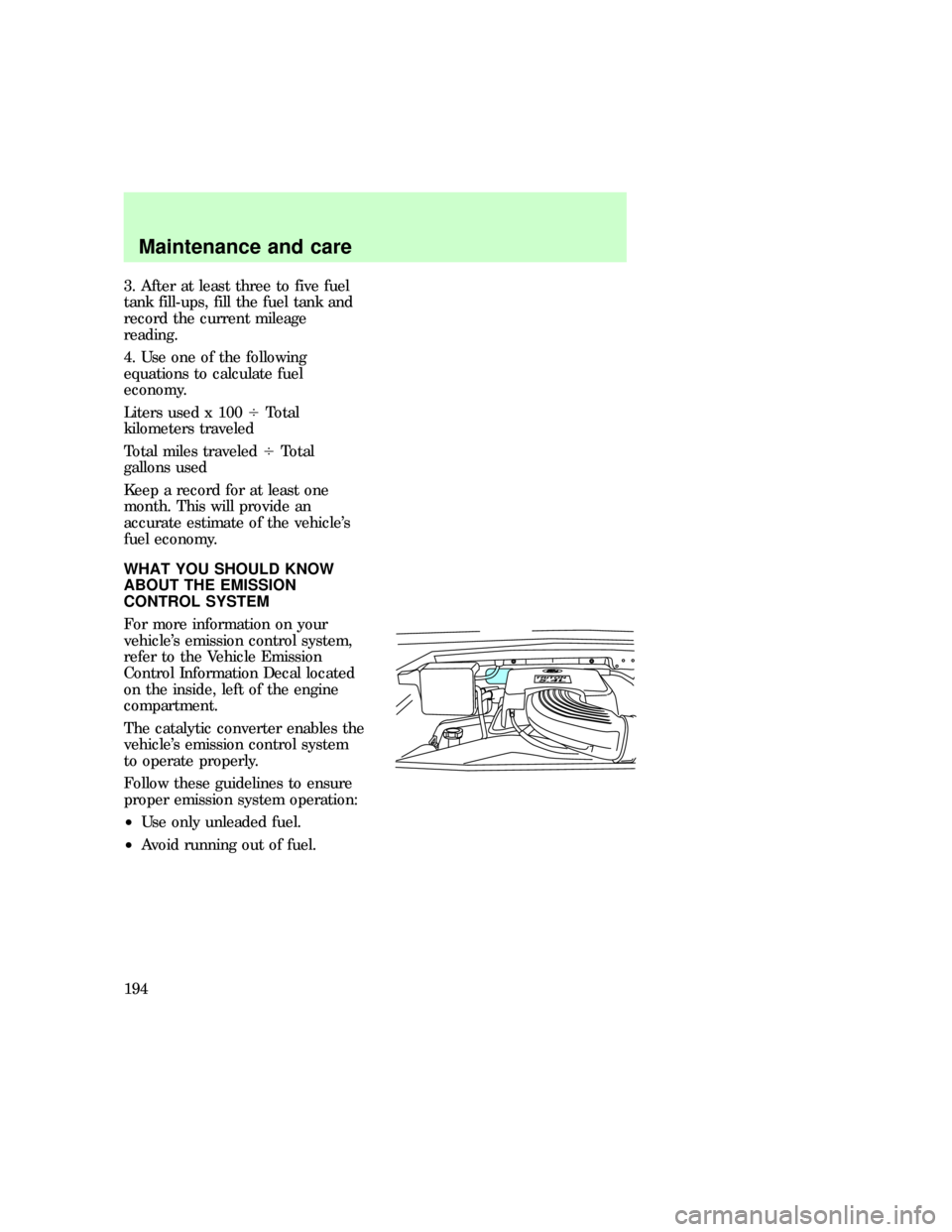
3. After at least three to five fuel
tank fill-ups, fill the fuel tank and
record the current mileage
reading.
4. Use one of the following
equations to calculate fuel
economy.
Liters used x 1004Total
kilometers traveled
Total miles traveled4Total
gallons used
Keep a record for at least one
month. This will provide an
accurate estimate of the vehicle's
fuel economy.
WHAT YOU SHOULD KNOW
ABOUT THE EMISSION
CONTROL SYSTEM
For more information on your
vehicle's emission control system,
refer to the Vehicle Emission
Control Information Decal located
on the inside, left of the engine
compartment.
The catalytic converter enables the
vehicle's emission control system
to operate properly.
Follow these guidelines to ensure
proper emission system operation:
²Use only unleaded fuel.
²Avoid running out of fuel.
exd_emission-control
Maintenance and care
194
Page 194 of 224
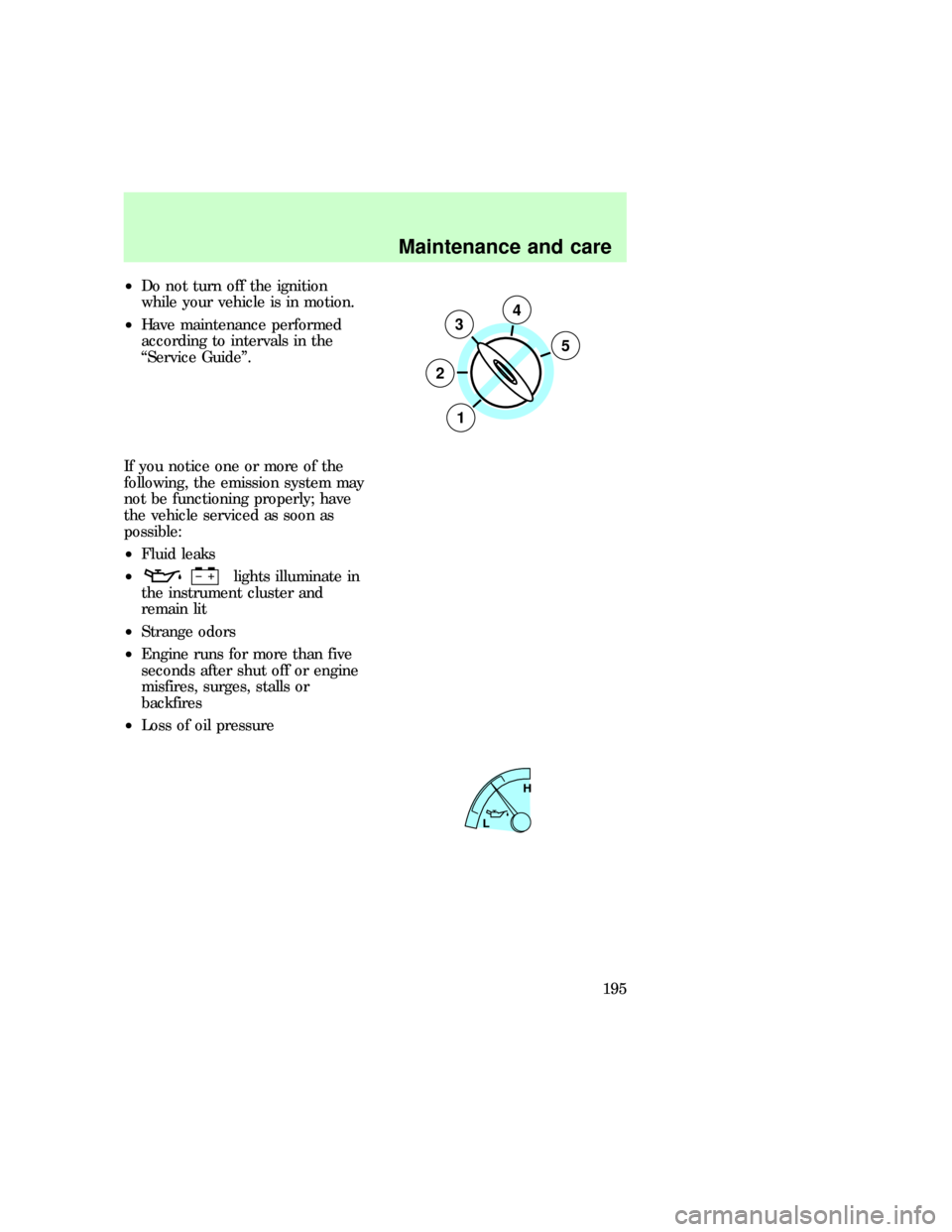
²Do not turn off the ignition
while your vehicle is in motion.
²Have maintenance performed
according to intervals in the
ªService Guideº.
If you notice one or more of the
following, the emission system may
not be functioning properly; have
the vehicle serviced as soon as
possible:
²Fluid leaks
²
lights illuminate in
the instrument cluster and
remain lit
²Strange odors
²Engine runs for more than five
seconds after shut off or engine
misfires, surges, stalls or
backfires
²Loss of oil pressure
34
5
2
1
LHLH
exd_emissions_info
Maintenance and care
195
Page 195 of 224
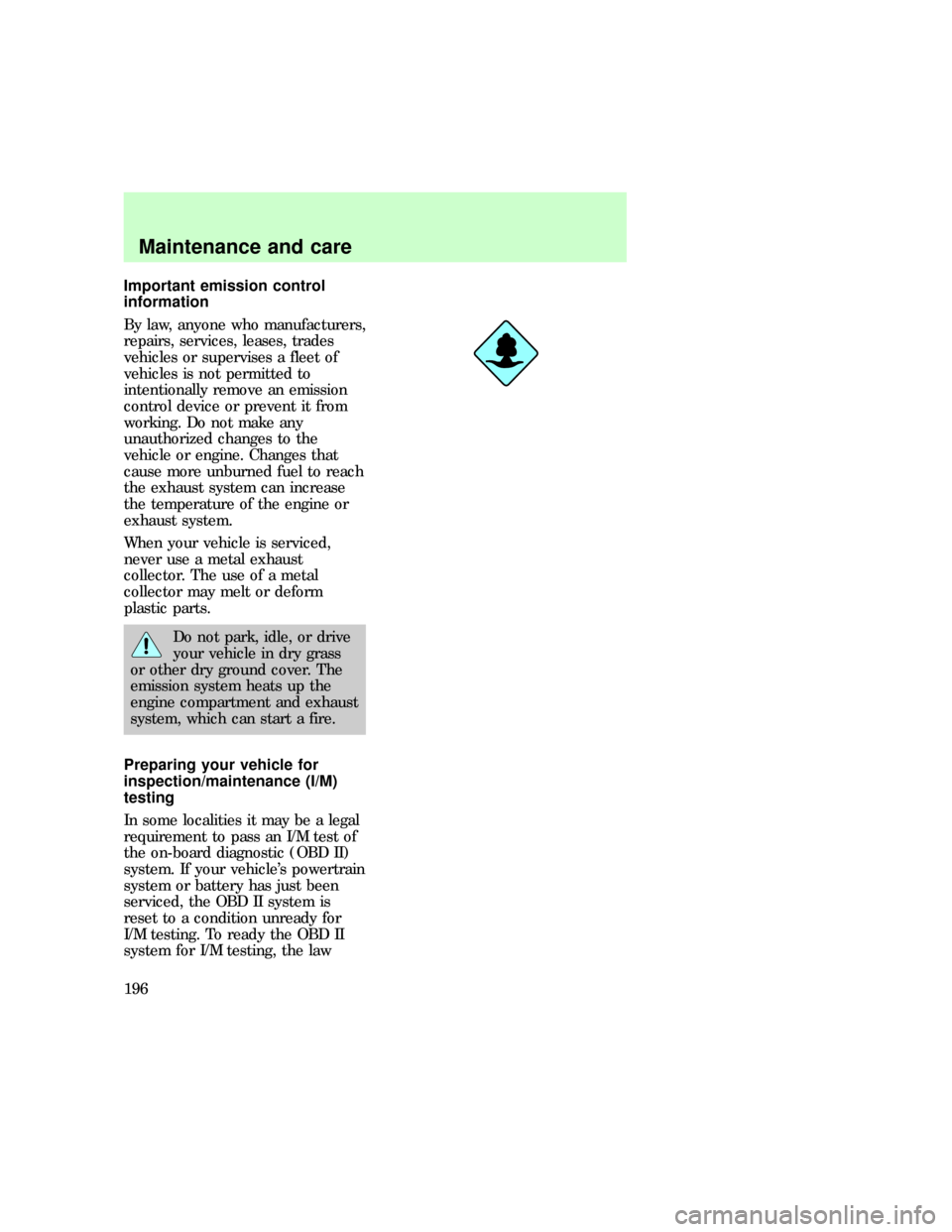
Important emission control
information
By law, anyone who manufacturers,
repairs, services, leases, trades
vehicles or supervises a fleet of
vehicles is not permitted to
intentionally remove an emission
control device or prevent it from
working. Do not make any
unauthorized changes to the
vehicle or engine. Changes that
cause more unburned fuel to reach
the exhaust system can increase
the temperature of the engine or
exhaust system.
When your vehicle is serviced,
never use a metal exhaust
collector. The use of a metal
collector may melt or deform
plastic parts.
Do not park, idle, or drive
your vehicle in dry grass
or other dry ground cover. The
emission system heats up the
engine compartment and exhaust
system, which can start a fire.
Preparing your vehicle for
inspection/maintenance (I/M)
testing
In some localities it may be a legal
requirement to pass an I/M test of
the on-board diagnostic (OBD II)
system. If your vehicle's powertrain
system or battery has just been
serviced, the OBD II system is
reset to a condition unready for
I/M testing. To ready the OBD II
system for I/M testing, the law
exd_im_testing
Maintenance and care
196
Page 196 of 224

specifies that additional city and
highway driving is necessary to
complete the check of the OBD II
system.
The driving modes required to
reach the ready condition consist
of a minimum of 30 minutes of city
and highway driving:
²At least 20 minutes driving in
stop and go city-type traffic with
at least four idle periods.
²At least ten minutes of driving
on an expressway or highway.
Before completing the above
driving modes, the engine must be
warmed up and at operating
temperature. Once started, the
vehicle must not be turned off
during these modes.
exd_bulbs
Maintenance and care
197
Page 197 of 224
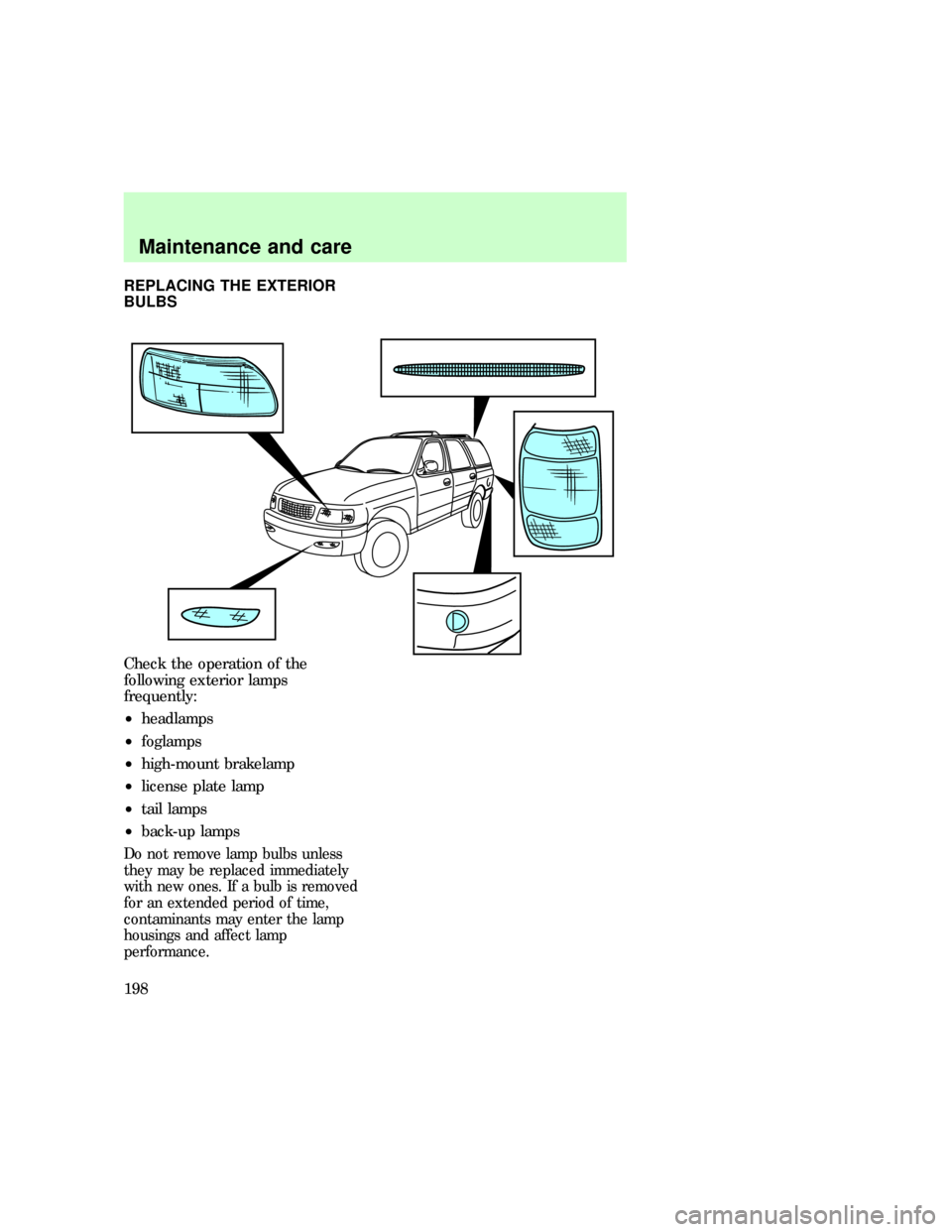
REPLACING THE EXTERIOR
BULBS
Check the operation of the
following exterior lamps
frequently:
²headlamps
²foglamps
²high-mount brakelamp
²license plate lamp
²tail lamps
²back-up lamps
Do not remove lamp bulbs unless
they may be replaced immediately
with new ones. If a bulb is removed
for an extended period of time,
contaminants may enter the lamp
housings and affect lamp
performance.
Maintenance and care
198
Page 198 of 224
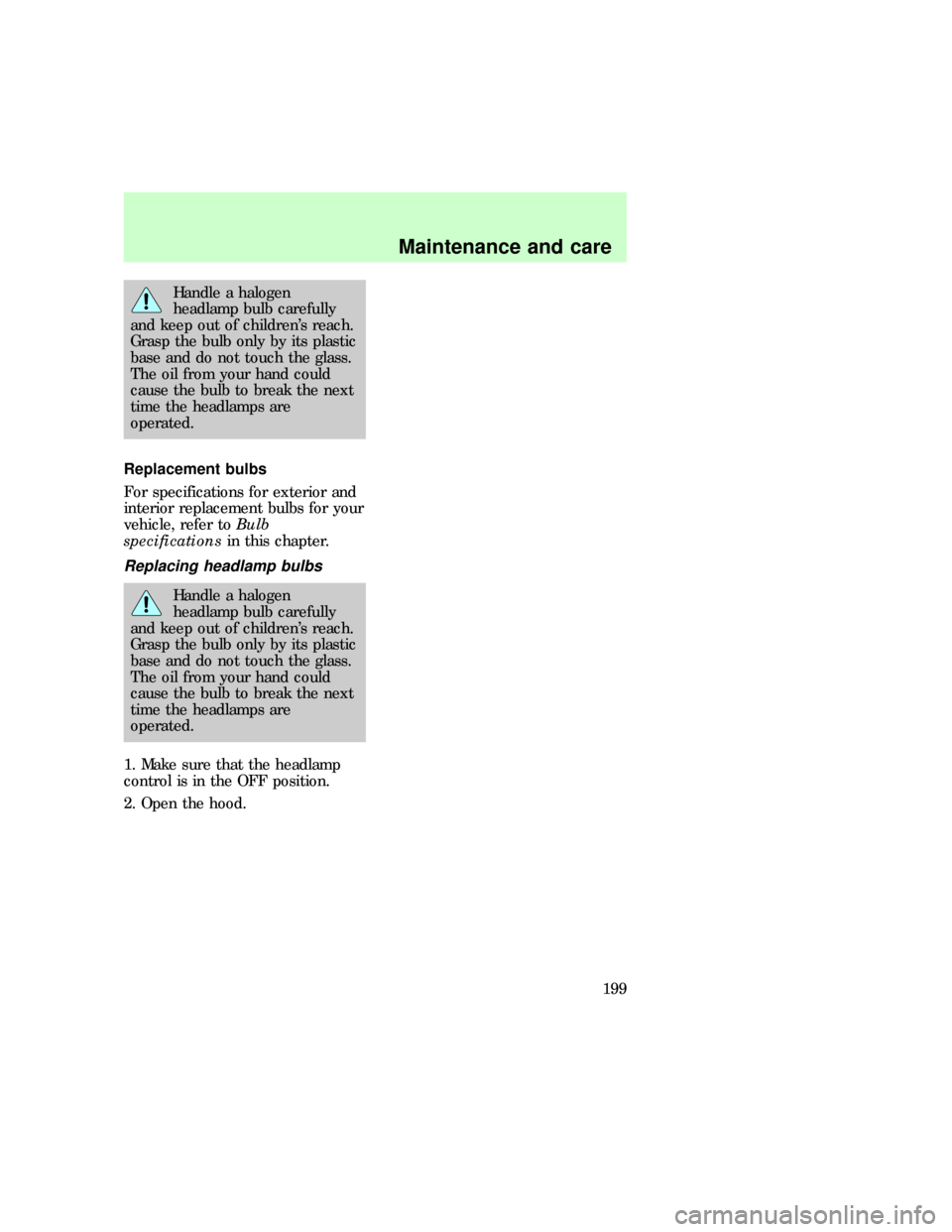
Handle a halogen
headlamp bulb carefully
and keep out of children's reach.
Grasp the bulb only by its plastic
base and do not touch the glass.
The oil from your hand could
cause the bulb to break the next
time the headlamps are
operated.
Replacement bulbs
For specifications for exterior and
interior replacement bulbs for your
vehicle, refer toBulb
specificationsin this chapter.
Replacing headlamp bulbs
Handle a halogen
headlamp bulb carefully
and keep out of children's reach.
Grasp the bulb only by its plastic
base and do not touch the glass.
The oil from your hand could
cause the bulb to break the next
time the headlamps are
operated.
1. Make sure that the headlamp
control is in the OFF position.
2. Open the hood.
exd_ext_replacement_bulbs
exd_headlamps_turnsignals
Maintenance and care
199
Page 199 of 224
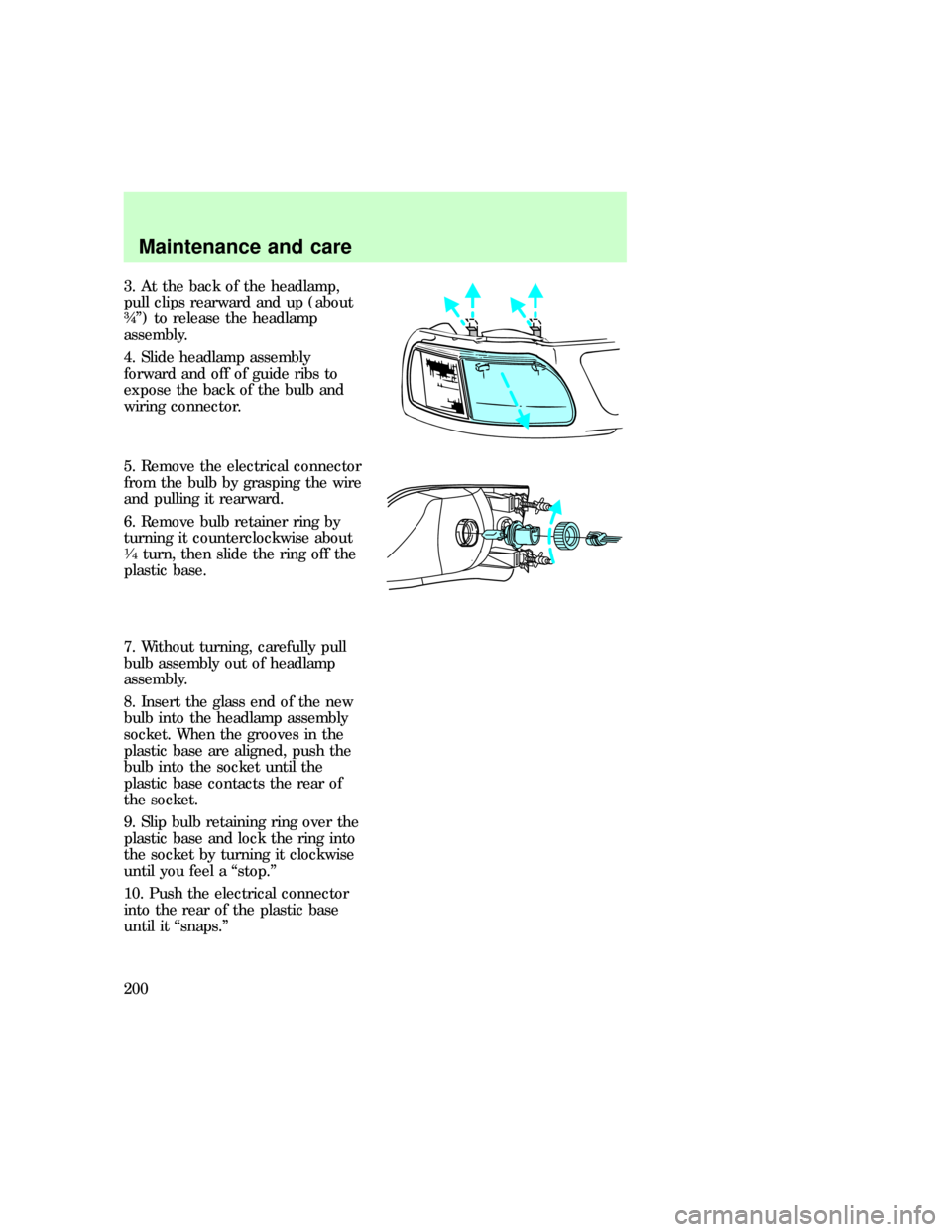
3. At the back of the headlamp,
pull clips rearward and up (about
ôº) to release the headlamp
assembly.
4. Slide headlamp assembly
forward and off of guide ribs to
expose the back of the bulb and
wiring connector.
5. Remove the electrical connector
from the bulb by grasping the wire
and pulling it rearward.
6. Remove bulb retainer ring by
turning it counterclockwise about
1¤4turn, then slide the ring off the
plastic base.
7. Without turning, carefully pull
bulb assembly out of headlamp
assembly.
8. Insert the glass end of the new
bulb into the headlamp assembly
socket. When the grooves in the
plastic base are aligned, push the
bulb into the socket until the
plastic base contacts the rear of
the socket.
9. Slip bulb retaining ring over the
plastic base and lock the ring into
the socket by turning it clockwise
until you feel a ªstop.º
10. Push the electrical connector
into the rear of the plastic base
until it ªsnaps.º
Maintenance and care
200
Page 200 of 224
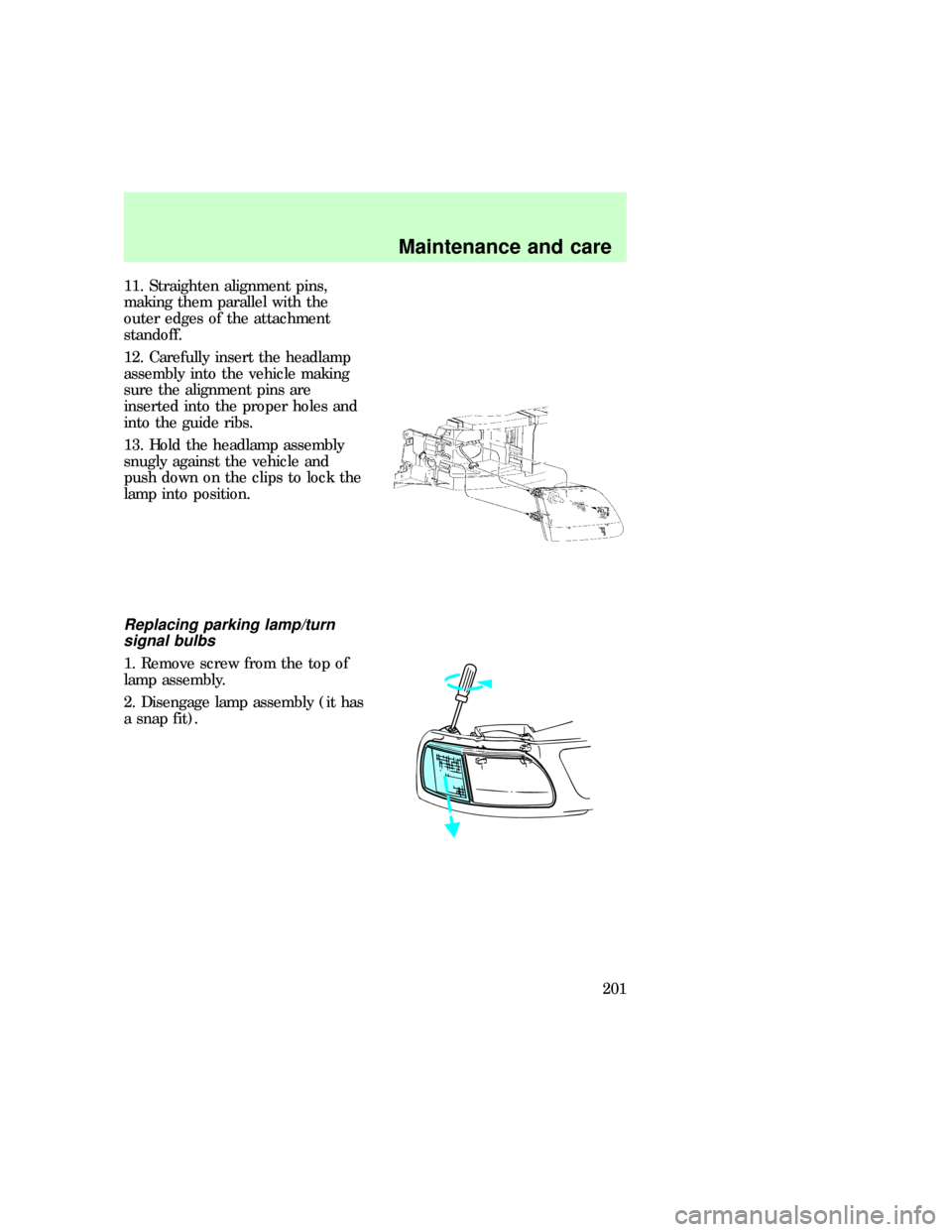
11. Straighten alignment pins,
making them parallel with the
outer edges of the attachment
standoff.
12. Carefully insert the headlamp
assembly into the vehicle making
sure the alignment pins are
inserted into the proper holes and
into the guide ribs.
13. Hold the headlamp assembly
snugly against the vehicle and
push down on the clips to lock the
lamp into position.
Replacing parking lamp/turn
signal bulbs
1. Remove screw from the top of
lamp assembly.
2. Disengage lamp assembly (it has
a snap fit).
Maintenance and care
201